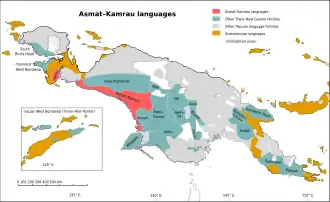Asmat–Kamrau languages
| Asmat–Kamrau | |
|---|---|
| Geographic distribution | southern coast and Kamrau Bay of Indonesian New Guinea |
| Ethnicity | Asmat people etc. |
| Linguistic classification | Trans–New Guinea
|
| Subdivisions | |
| Language codes | |
| Glottolog | asma1256 |
 Map: The Asmat–Kamrau languages of New Guinea
The Asmat–Kamrau languages
Other Trans–New Guinea languages
Other Papuan languages
Austronesian languages
Uninhabited | |
The Asmat – Kamrau Bay languages are a family of a dozen Trans–New Guinea languages spoken by the Asmat and related peoples in southern Western New Guinea. They are believed to be a recent expansion along the south coast, as they are all closely related, and there is little differentiation in their pronouns.
Languages
- Kamrau Bay (Sabakor):[3]
- Buruwai (Sabakor)
- Kamrau
- North Kamberau (Iria)
- South Kamberau (Asienara)
- Asmat–Kamoro[4]
Proto-language
Phonemes
Usher (2020) reconstructs the consonant inventory as follows:[5]
m n p [t] k b [d] ɟ ɡ [ɸ] s w r j
There is near complementary distribution between *p and *ɸ. *t and *d are marginal, appearing in only a few words. *r does not occur initially. There are no consonant clusters.
Vowels are *a *e *i *o *u.
Pronouns
Ross (2005) reconstructs the proto-Asmat–Kamoro pronouns as:
sg pl 1 *no[ro] *na[re] 2 *o[ro]/we[rV] *ca[re] 3 *a[re]
Usher (2020) reconstructs the free proto–Asmat–Kamrau Bay pronouns as:[5]
Proto-Asmat–Kamrau sg pl 1 *no-rV *na-rV 2 *o-rV *ɟa-rV 3 *a-rV Proto-Kamrau sg pl 1 *nor *nar 2 *or-or *er-er 3 *ar-ar Proto-Asmat–Kamoro sg pl 1 *no-ro *na-rV 2 *o-ro *ca-rV 3 *a-rV Basic vocabulary
Some lexical reconstructions by Usher (2020) are:[5]
gloss Proto-Asmat-Kamrau Proto-Kamrau Bay Proto-Asmat-Kamoro Proto-Asmat Proto-Muli Strait head *uɸu *jebin *ufu *kowisi 'head/skull' *ɣo̝p 'head/hair'; *uɔndVro̝m 'head/skull' hair *ɸini *ɸin *fini *ɸinV 'hair/feather(s)' *sin ear *jiɸ[a/o]ne *jaɸ[a/o]m *jafane *jaɸane *ie̝pær eye *manaN *manam *mana *mana *musiɣ nose *miC *mik *mi *mi *mæne̝ɣ 'nose/tip' tooth *siC *sik *sisi *sisV *ziɣ tongue *komane *[a]mam *komane *komVne *ndupæn foot/leg *mawu *mawu *mawu *mawi *kaŋg 'leg' blood/red *ese *et *ese *ir 'blood' fruit/seed/bone *eake *eke *eake skin/bark *ɸu *pitini *pitʲini *par breast *awo *awo *awo *abuɣ louse *amo *om *amo *am dog *juwuɾi *iwuɾ *juwuri *juwVɾi *i[u]bui pig *oɸo *ok *ofo *up bird *geɟ *sakV egg *[a]sa *asa *sa *sa tree/wood *ose *o *ose *to̝ 'tree' man/male *bewu *nam 'man/person' woman *ɟawoɟa *jawoɟa *cawoca *jipitʲi *ie̝t 'woman/wife' sun *jawu *asi 'sun/day' *jawu *jawi *zaua moon *buɾa *buɾa *pura *piɾa *irind water *m[oi/ui] *moɟ *mui *mui *mo̝i fire/firewood *usa *usa *usa *jusa *ua[nd/r] 'fire' stone *jeta *eta *j[e]ka *mæte̝ path *matoC; *mak *mato name *uwase *u *uwase *juwase *ur eat/drink *n[a]- *n[a]- *n[e/a] *ne- *no̝ku one *ɟawa[kV] *-ɟawa *cawak[e/a] *tʲawaka two *kaboma *aboma *kapoma; *jam[i/u]nV
Evolution
Proto-Asmat-Kamoro reflexes (Voorhoeve 2005)[6] of proto-Trans-New Guinea (pTNG) etyma, as listed in Pawley & Hammarström (2018):[7]
- *fiti ‘fingernail’ < pTNG *mb(i,u)t(i,u)C
- *isi ‘mosquito’ < *kasin
- *ese ‘blood’ < *kenja
- *masap or *masip ‘saliva’ < *si(mb,p)atV
- *yi ‘urine’ < *[si]si
- *asa ‘excrement’ < *asa
- *manaka ‘eye’ < *mun(a,e,i)ka
- *sisi ‘tooth’ < *(t,s)i(t,s)i
- *yirama ‘night’ < *k(i,u)tama
- *tama ‘morning’ < *k(i,u)tama
- *na- ‘eat’ < *na-
References
- ^ New Guinea World, Asmat – Kamrau Bay
- ^ Usher, Timothy; Suter, Edgar (2020). "The Asmat-Muli Languages of Southwestern New Guinea" (PDF). Language & Linguistics in Melanesia. 38. Port Moresby: Journal of the Linguistic Society of Papua New Guinea. ISSN 0023-1959.
- ^ New Guinea World, Kamrau Bay
- ^ New Guinea World, Asmat–Kamoro
- ^ a b c "Asmat-Kamrau Bay - newguineaworld".
- ^ Voorhoeve, Clemens L. 2005. Asmat-Kamoro, Awyu-Dumut and Ok: An enquiry into their linguistic relationship. In Pawley, Andrew and Robert Attenborough and Golson, Jack and Hide, Robin (eds.), Papuan Pasts: Studies in the Cultural, Linguistic and Biological History of the Papuan-speaking Peoples, 145-166. Canberra: Research School of Pacific and Asian Studies, Australian National University.
- ^ Pawley, Andrew; Hammarström, Harald (2018). "The Trans New Guinea family". In Palmer, Bill (ed.). The Languages and Linguistics of the New Guinea Area: A Comprehensive Guide. The World of Linguistics. Vol. 4. Berlin: De Gruyter Mouton. pp. 21–196. ISBN 978-3-11-028642-7.
Bibliography
- Drabbe, Piet. 1953. Spraakkunst van de Kamoro-taal. The Hague: Martinus Nijhoff.
- Drabbe, Piet. 1963. Drie Asmat-dialecten. Verhandelingen van het Koninklijk Instituut voor Taal-, Land- en Volkenkunde, No. 42. The Hague: Martinus Nijhoff.
- Ross, Malcolm (2005). "Pronouns as a preliminary diagnostic for grouping Papuan languages". In Andrew Pawley; Robert Attenborough; Robin Hide; Jack Golson (eds.). Papuan pasts: cultural, linguistic and biological histories of Papuan-speaking peoples. Canberra: Pacific Linguistics. pp. 15–66. doi:10.15144/PL-572. ISBN 0858835622. OCLC 67292782.
- Voorhoeve, C.L. 1965. The Flamingo Bay Dialect of the Asmat language. Verhandelingen van het Koninklijk Instituut voor Taal-, Land- en Volkenkunde, No. 46. The Hague. doi:10.26530/OAPEN_613367
- Voorhoeve, C.L. 1968. "The Central and South New Guinea Phylum: a report on the language situation in south New Guinea." Pacific Linguistics, Series A, No. 16: 1–17. Canberra: The Australian National University.
- Voorhoeve, C.L. 1975. Languages of Irian Jaya: Checklist, Preliminary Classification, Language Maps, Wordlists. Pacific Linguistics, Series B, No. 31. Canberra: The Australian National University.
- Voorhoeve, C.L. 1980. The Asmat Languages of Irian Jaya. Pacific Linguistics, Series B, No. 64. Canberra: The Australian National University.
- Wurm, Stephan Adolphe. 1983. The Papuan Languages of Oceania. Ars Linguistica 7. Tübingen: Narr.
External links
- Timothy Usher & Edgar Suter, New Guinea World, Proto–Asmat – Kamrau Bay